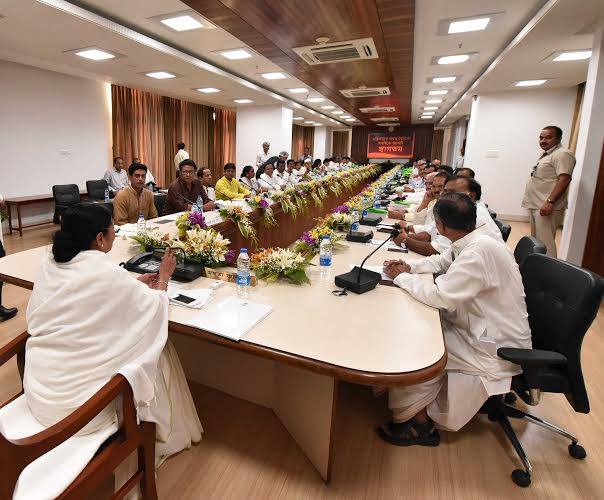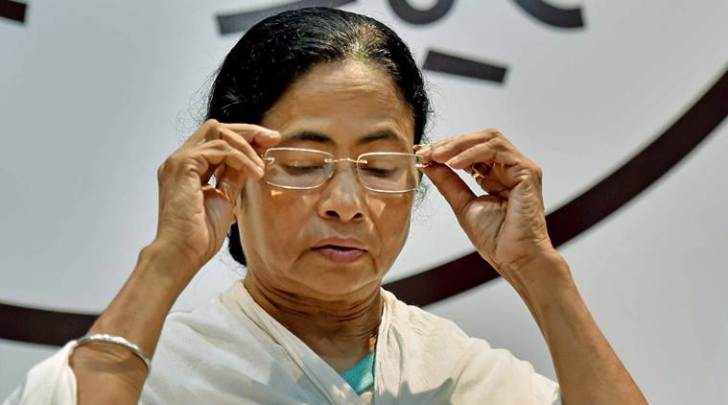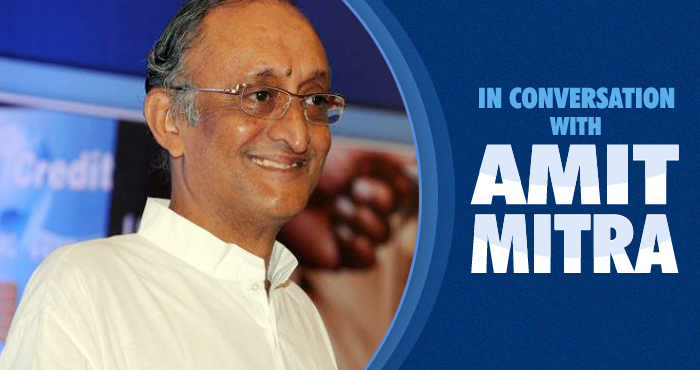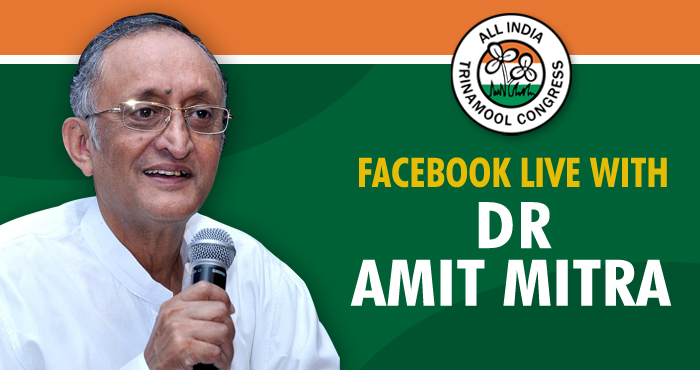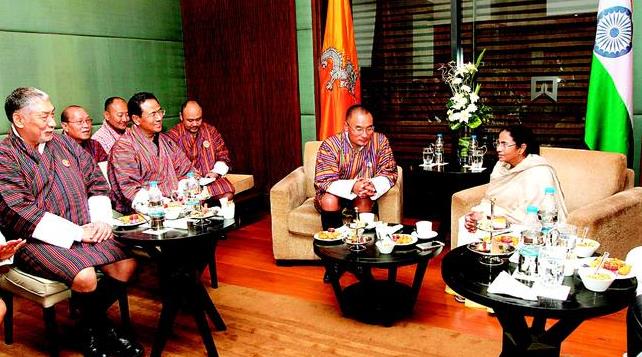Excerpts of the interview of West Bengal Finance & Industry Minister Dr Amit Mitra with Sekhar Gupta on the show Walk the Talk aired on April 30, 2016 on NDTV
Q: Has all the over-all development in the State shifted the political discourse in Bengal?
Dr Mitra: I think the key I find for elections for example, is development, and how that development has touched the lives of the people. I can talk about the GDP growth which is much higher than the rest of India, industrial growth which too is much higher than in rest of India, agricultural growth which is phenomenally higher than rest of India, even services growth is higher than in rest of India.
What is interesting to me is when we came to office, we came with a 2 lakh crore debt on our neck. Another interesting thing I found, which Mamata Banerjee and I talked about, is that the capital expenditure which create the assets all around – the roads, the parks, everything – that had gone down. It was reduced to minus 26%, can you believe that? You’ll be happy to know that in five years it has now become six times.
Q: So you mean, capital expenditure for the layman is what the government spends on building infrastructure or schools or colleges, roads, etc, and not for paying salary and debt?
Dr Mitra: Yes. So on one hand, they were borrowing like crazy. On the other hand they were not spending it on hard asset-creating development. So I don’t know where the money went. So that’s where we started from and today it is six times. Today Mamata Banerjee has turned to social infrastructure – health, education, rural development – all of these have gone up between 3 times to 6 times in the last 5 years, where people’s lives have been touched, including the lives of villagers.
Q: But does it work in politics? Is good economics good for politics in Bengal because usually it isn’t so around the world?
Dr Mitra: What is interesting is that I take Khardah, my constituency, as an example. As I walked, people came, women came and were throwing flowers at me. When I asked them the reason, they told me “You have built this road in front of our houses. You have built this drainage system.”
Q: And the person incumbent before you was holding the same job as you hold now?
Dr Mitra: For 24 years he was the Finance Minister and yet he didn’t do this development. One lady came up to me and said “You’ve upgraded this girls’ school in a remote village. And the best thing you’ve done is introducing a science laboratory there. My daughter has received the Kanyashree benefit (Rs 25,000 at the age of eighteen). She is going to be a scientist.” All this was said to me by a woman from a village.
Q: So if economy is the issue now, if good economics is good politics, then is this election already a done thing for you?
Dr Mitra: I think so too. I think it will be so, despite all the noise. If you track the sound as against the noise, you’ll find people are talking about this, because their lives have been touched. This is a test. Does massive development and transformation of Bengal convert itself into votes? My view is that to a very great degree it converts into votes.
Q: Unlike others of your ilk – economists, experts, technocrats who have come to politics, you did not come through the indirect route. You actually contested elections for the first time in your life against a tough opponent…
Dr Mitra: Yes, in 2011.
Q: All of know you from your Delhi days when you were in FICCI amidst corporate India and also as a supporter of liberal economy, tell us the story which you haven’t discussed much, about how you got in touch with Mamata Banerjee, how did your tryst with politics happen?
Dr Mitra: You see, my father was a leader of the Congress; he was a Deputy Speaker and Acting Speaker here. He was known to Mamata Banerjee and most interestingly I spent 18 years of my younger life almost a kilometre and a half away from where she lives, which is the most quintessential, lower middle-class, and it all combined into a beautiful ‘adda’ session at the ‘rawk’. So we had something generically common in the way we grew up. ‘Rawk’ is usually steps of somebody’s house which they have offered for you to sit in the evening and indulge in ‘adda’ which is totally eclectic in class, in level of income, in interest. So what gave me an interest in common people’s lives is this ‘rawk’. There was this guy from the bustee across the street, with whom I used to play marbles, he would always come, without caring about who I was or which school I went to. I was in fact caught once by my grandmother who was going past us and complained to my father about letting me play marbles with those poor children. You know what my father did? He told me “Why couldn’t you hide?” He never asked me not to play with them, because being a politician he knew that exposure with the common people was a must.
Q: But you did not join politics for a very long time. You joined politics very late. How did that happen?
Dr Mitra: I think what happened was that I could not come back to Bengal to do what I am doing today in support of Mamata Banerjee. Why? Because when we were in college we got beaten up by the Communists. Our college was closed for 8 months. Everybody knew that here was this ‘reactionary fascist’ – that was their term. So I knew that if I came back to Bengal, I would not even be able to give advice, forget making decisions which I can today alongside Mamata Banerjee. So I stayed away. I had even gone to Bihar and worked for rural development for 3 years, but I couldn’t come to Bengal. At some point I was working with Mamata Banerjee in the Railways as Chairman of the Public Private Partnership (PPP) Committee as well as on certain other things. I had helped her with a report on Vision 2020 for the Railways which she did with me providing a lot of inputs. Also I helped on a paper on Finances. That is the time I realised that this lady, with her vibrancy and sacrifices in Bengal, she would be the only one who can defeat the Communists and change Bengal.
Q: So did you go to her and asked for joining politics or it was she who asked you?
Dr Mitra: Well interestingly, it happened in a seminar where I made a presentation on Railways, that’s how we came to know each other. Finally one day she called me one day around February 2011 just before the Assembly elections, while I was already working with her and advising her on different dimensions of Railways. She called me and said, “Amit-da, you’ve been all over the world, you’ve been in so many committees. Enough. Come with me and come and work for Bengal with me.” I asked for 24 hours to be able to consult with my wife. Mamata Banerjee told me that this was the time when I could make a difference. I left all my work. She even identified my constituency which I didn’t know anything about. It was a very tough constituency where I had to fight the then Finance Minister of Bengal who had won from there for 24 years. But Mamata Banerjee was confident that I would win from there despite the odds.
Q: I may be wrong, but wasn’t the former Finance Minister Asim Dasgupta also seen as a member of the reformist group within the CPI(M) along with Buddhadeb Bhattacharjee in West Bengal?
Dr Mitra: I think the CPI(M) is not run by Asim Dasgupta or by Buddhadeb babu. It is run by hardcore apparatchiks who work from a building which everybody knows about, from where the odd has come. So in a party like theirs, there can never be an initiative from people other than the General-Secretary of the party. So whether it is Buddha babu or it is Asim babu, they had to work within the party’s self-interest and this where I think the danger came from. Because very soon they converted the whole thing to a ‘party interest maximisation’, as against maximisation of the interest of the people. This is why development never happened here.
Q: So do you think they’ve learnt a lesson now?
Dr Mitra: I am sure people learn. But the problem is can they change the structure in the neo-Fascist party, which the Communists always are?
Q: But they let Manik Sarkar in Tripura carry on…
Dr Mitra: May be in Manik Sarkar’s case, the party is not so clearly apparatchik-based as usually in a fascist Communist party, may be they’ve given him a long rope…
Q: You’re using tough language – “Fascists” …
Dr Mitra: Yes. That is because the first telephone call I got when I became an MLA was from the police station. When I asked them the reason for calling they said, “There was an incident this morning and what are we supposed to do? Till three days ago, we were dictated by the LC or the Local Committee of the CPI(M), whether we can accept an FIR, which sections of the IPC should be put, etc. So please tell me who do I go to?” This is the reason why I call them Fascists. Because the police also was run by the Party from the Local Committee or LC, the most powerful entity! And not even by the MLA Asim Dasgupta, but their guy on the ground. This is how Communists are different from other political parties.
Q: You’ve defeated CPI(M) once, so I think you can defeat them may be forever, but now you are dealing with the CPI(M) and the Congress together. How much of a surprise was it for you? Were you taken aback when this happened?
Dr Mitra: You know why it is a surprise intellectually as well as practically is that in my constituency, if you go 100 metres, you will find a Shahid Bedi, a memoriam which says that the CPI(M) has murdered my so and so from the Congress party; and every morning they put garlands on it. Then you go another 100 metres, you will find the Congress person with a memoriam in the opposite direction, the Shahid Bedi of killing each other. Do you know that in 1991, there was a guy whose both hands were cut off by the CPI(M) because he voted, they said, for the hand signal. And he came to her meeting recently without hands. Now the same hand cut off by the CPI(M) has become a partner with us. Do you expect that guy whose hands have been cut off, will go and vote for the Congress or the CPI(M)?
Q: Why did this happen?
Dr Mitra: I think it happened out of desperation. They knew that we will win because of the massive developmental work we have done. 70% of Bengal lives in rural Bengal. Do you know 8,000 roads have been built in rural Bengal? So the CPI(M) were worried that with the kind of development in 5 years, they would be beaten badly. So they were pulling at straws. Now the Congress had no place to go. They had completely denuded themselves. So they said, we will go there. But do you remember, Lenin had written a piece called United Front Communist Tactics on going like a chhoonch (a needle); going like a needle, coming out like a boat. This is what Lenin had advised the German Communist Party for which Rosa Luxemburg got killed because she differed with him.
Q: Now India has seen the rise of strong regional parties from regional leaders. Like there is Mayawati, there is Jayalalitha, Mulayam Singh Yadav, Nitesh, Lalu, all exactly the same example. Say the Badal family in Punjab. So party is just like a group following one person. One person does become dictatorial within the party. The common trend is nobody can look at the leader or the supremo in the eye and disagree or give another point of view. Can you do that with Mamata?
Dr Mitra: I think not only can I do that, there have been occasions where we have debated issues. Yesterday you were with her I believe. What did you get a sense of? Did you get that sense?
Q: With public she is totally like a people’s person…
Dr Mitra: That is her real self.
Q: In fact, that is what I call her, the ultimate populist. Now she has competition in Arvind Kejriwal.
Dr Mitra: I think the most important thing is that is the real self where she is very warm, very friendly. And she has a connect with the common people. She gets 500 SMSes a day of information. She responds to at least 350-400 because that is continuously direct feedback from the people. So my sense is, this development, this massive development in Bengal, which you’ve never talked about at the national media, would not have happened but for the pressure. I’ll give you an example. How did I manage to increase my planned expenditure five times. Expenditure not allocation. Mamata Banerjee went to 105 meetings in the districts where she shifted the whole of the Cabinet as well as the Secretariat to the district. Only, single agenda, have you implemented those projects?
Q: But, does all of that make you recover from the Singur blot. Because you drove a big corporate house out. You made a prestige issue of it. People are unhappy they are sitting there, they haven’t got money from land, they haven’t got jobs; the factory has not come. Would you ever turn the clock back on it?
Dr Mitra: Well I will just tell you 2 things on that; very good question you are asking me. One is, have the Tatas left Bengal? 40,000 people work for Tatas here.
Q: That is true but that is elsewhere. This is Singur…
Dr Mitra: Let me get back to Singur. 20,000 additional people will go into TCS.
Q: I know, we just drove past TCS.
Dr Mitra: You just drove past. Now, it is not only TCS. Tata Hitachi, Tata Metaliks is expanding. Now, therefore this is a myth that the Tatas have left if anybody thinks so. Largest employment in the State is by their group. Two – in 600 acres of land, people accepted cheques. No problem with that. In 400 acres of land about 2,000-plus farmers did not. But they were all coerced into building this factory by the Left Front Government. What has Mamata Banerjee said? 600 acres legitimately – the Government has paid the cheques. You come back and these 600 acres can be used for any kind of factory. You come and build the factory. As for the 400 acres and people who did not accept cheques, we will decide then. But you commit to come back for the 600 acres for building a massive factory.
Q: And for the rest you are open to negotiation?
Dr Mitra: The rest will for be the next phase when the farmers who are receiving rice at Rs 2 today speak their mind; I don’t know whether you saw that another channel had gone there and they had said that the people had said that we are better off because of Rs 2/kg rice. They have roads built for them, they are getting water. They said that someday, they will get their land back. This was the optimism.
Q: Or some day they will get the factory…?
Dr Mitra: Factory is for the 600 acres, which Mamata Banerjee has publicly said, which I’m sure has reached the Tatas. I’ll make sure the coming back happens. So my submission is as far as Singur is concerned, the Tatas are the biggest player in West Bengal today and and still growing.
Q: And yet you called Ratan Tata rude things.
Dr Mitra: No no, that is because unfortunately Ratan Tata whom I know very well, he came to Kolkata and suddenly in some meeting of women entrepreneurs, he said “Oh I was coming through this Rajarhat area, and I saw these buildings coming up, it looked to me that most of it is a village.” Now you tell me. You have driven through this, does this skyline look like a village?
Q: This is Kolkata. You can have a pond in the middle of this technology village, children are bathing in it. You can have a cow.
Dr Mitra: And you can have those buildings around you which are world-class, employing 150,000 IT people. My submission there is, therefore, we have to remember that we have pushed this forward. Mamata Banerjee has personally has said in a public meeting that Tatas can come back in the 600 acres.
Q: So what will you tell Ratan Tata personally? You also know what he’s like. You know his mind. What will you tell him personally?
Dr Mitra: You know, I’ll give you one more thing. No businessman in my experience in business has ever said bad M and good M, if you recall. Ratan Tata had said before leaving, Mamata is bad, Modi is good. No businessman ever says this. So obviously there is an element to that. Though he has done great work, I respect him for that. Still he would make these kinds of comments. Now my problem was having made this completely wrong comment, without doing anything, do you expect Rajarhat to have industry? He said there is no industry. This is where the IT hub is, this is where the populace is. So why did he say this?
Q: So what will you tell him now?
Dr Mitra: I would tell him what Mamata Banerjee has said in public. That 600 acres are there. Mr. Tata, though somebody else has taken over as Chairman, you persuade that person to come back, because 40,000 of your people are here; it is going to become 60,000 very soon with TCS. You have a stake in Bengal.
Q: The Tatas have a history in Bengal, so Ratan Tata should still come and have a cup of tea with Mamata Banerjee…
Dr Mitra: I’m sure when Mamata Banerjee said this in public, this has been communicated. Now it’s a personal issue, if Mr. Tata feels comfortable there will be connection. She has said it in public. Come back for the 600 acres. And now that Mr. Mistry is the Chairman, so he has to take his own call. I’m sure he will seek advice from Ratan Tata. I think there is no inherent conflict in there for that was something the Left Front government did.
Q: If you come to power, I hope you will be able to turn back the clock on what was an unhappy chapter in Bengal’s economic history. Equivalent to something like this will come up in Singur.
Dr Mitra: I think the first move made by Mamata Banerjee…
Q: So will they will come for the 600 acres?
Dr Mitra: Yes, and the 400 acres for which the cheques were not accepted, we will give back their land if they want it back. Mamata Banerjee will back them up that with her life – it is for this that she did 27 days of hunger strike. She would have died. And she put that stake for the 400 acre owners who had not accepted the cheques. And CPI(M) bulldozed that area to take over, if you go there you will see all 1,053 acres have been taken away.
Q: We have met people in villages on both sides of the divide, people who were happy, now unhappy because the factories haven’t come, people who want their land back and people who lost their land, haven’t got the money and the factory hasn’t come.
Dr Mitra: All kinds of people have their views but Mamata Banerjee has made the first move in a public meeting; she has asked them to come back in the 600 acres – no problem with that as people have accepted cheques legitimately. She fought for the 400 acres farmers who were completely bulldozed.
Q: Can the Tatas manage in the land left?
Dr Mitra: Yes originally the Tatas had agreed, I see from the files, for 600 acres only, in Kharagpur. So originally 600 acres is what they had planned for.
Q: So this became much closer?
Dr Mitra: Much closer, it was 4 times cropped area, the most fertile area, from where Kolkata’s vegetables and everything are supplied.
Q: Yes, we’ve seen from bhindi to lauki to beans … everything.
Dr Mitra: Yes and the real bone of contention is the Left Front government bulldozed those people to take away their land. And if I were the Tatas at that time I would have debated that. Unfortunately, the Tatas were given that on a platter. They were given terms which were unusual. Where as they had originally identified 600 acres in Kharagpur. 600 acres to 600 acres makes a perfect match.
Q: See that’s why I think it’s very important, whatever happens in the elections now, some bit of this old Kolkata, old Bengal decency of arguing or disagreeing in a civil manner has restored. This has been a peaceful election till now. I do hope we head towards there. Because in no other city in India would you build a sculpture of a Baul singer with dogs admiring his music. In any city of India we would have put a statue of a political leader…
Dr Mitra: Yes, and here it is not Mamata Banerjee’s! Let me also add, since you mentioned Baul singers, there were only 2,000 folk singers registered when we came to office. Mamata Banerjee has increased that to 60,000 and giving them 1,000 rupees per month and telling them any program you go, you can make money from there. And for especially government programmes like Kanyashree, you inform the people about it and make additional money. So 60,000 folk singers are now here; so that sculpture which you see here in Rajarhat does have something very special. Because they have come back to life. Because they were not there before.
Q: So when I come back next time and the political season here has calmed down, get me a tutorial on Baul music. As we say, may the best player win.
Dr Mitra: Thank you.


